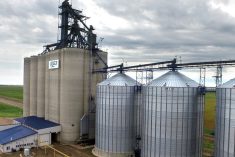CNS Canada –– The Canadian Wheat Board single desk has now been gone for 3 1/2 years, but there are still some in the Prairie farming community who would like to see it brought back.
Whether that’s actually possible is a question for another time — but the data being used to make the case for a return of the CWB single desk warrants closer scrutiny.
“Where’s the $6.5 billion?” asks Kyle Korneychuk, a former CWB director and current spokesperson for the Canadian Wheat Board Alliance, citing a figure that has worked its way to the forefront of calls for a renewed central marketing agency.
Read Also

U.S. grains: Soy futures set 15-month high after China agrees to purchases
U.S. soybean futures reached a 15-month high on Thursday after President Donald Trump’s administration said top-importer China agreed to buy tens of millions of tons of American crops in the next few years as part of a trade truce.
A group of 50 farmers in western Manitoba/eastern Saskatchewan unanimously passed a resolution on Feb. 12 “calling for the re-establishment of the Canadian Wheat Board and single-desk selling of grain in Western Canada.”
That call made its way to Ottawa. “The Canadian Wheat Board Alliance tells us the loss of the single desk system has meant a whopping $6.5 billion shortfall for grain farmers in just the past two years,” NDP leader Tom Mulcair during question period in the House of Commons on Tuesday.
Mulcair went on to ask whether or not the governing Liberal party “would help farmers and restore the Canadian Wheat Board.”
The question was met with deflection by Agriculture Minister Lawrence MacAulay, who noted the CWB had transitioned to privately-owned G3 Canada, “with no ties to the government.”
The question remains: Where is the $6.5 billion? Did farmers actually lose that much money because of the demise of the CWB? If so, what’s to be done?
The $6.5 billion figure comes from a study conducted by University of Saskatchewan agricultural economist Richard Gray.
Titled The Economic Impacts Of Elevated Export Basis Levels On Western Canadian Grain Producers 2012-13, 2013-14 And 2014-15, the actual study contains no mention of the CWB.
Rather, the research highlights wider-than-normal discrepancies between the prices at port at Vancouver and those received by farmers during the timeframe of the study, with railway logistics issues taking the brunt of the blame.
Wheat is a major component in the calculations used to reach the $6.5 billion number, but canola, oats and other crops that were never under the purview of the CWB single desk are also included.
The study can be found online on the Saskatchewan Wheat Commission website.
“A lack of transportation (and) grain handling capacity cost producers a lot of money,” said Gray when reached by phone and asked for the basic premise of the study.
The focus now, he said, should be on increasing the capacity of the system with the “Wheat Board issue way under the bridge.”
While he agreed the loss of the CWB’s single desk played a part in transportation issues of 2013-14 and 2014-15, Gray noted basis levels between the port and the country were still “normal” during the first year of the study in 2012-13, the first year without the CWB’s single desk.
Basis levels have “returned to normal this crop year as well,” said Gray.
“It’s all based on flawed analysis,” said John DePape, of Farmers Advanced Risk Management Co. (FarmCo) on efforts to link Gray’s findings to the loss of the CWB single desk.
The methodology of the study “is fraught with issues that lead to erroneous conclusions,” he said, and the calculations do not include all of the factors needed to accurately compare the Wheat Board era with the present day.
“When things are tight, and you have the capacity, they (grain companies) will pay up for it if they need it,” said DePape.
The logistical issues of the 2013-14 crop year left many companies plugged and unable to do extra business at any price, he said. However, even when grain companies don’t actually need to take delivery to meet a forward-contracted sale, they still offer a (lower) price to the producer.
Gray echoed that sentiment, noting grain handlers lower their bids when they can’t move what’s offered. A solution to that problem, he said, is increased capacity along the grain handling chain.
In addition, better price reporting and transparency, as is more widely available in the U.S., would also be beneficial.
CWBA’s Korneychuk, who farms at Pelly, Sask., about 110 km northeast of Yorkton, allowed that bringing back the single desk may be an uphill battle.
While the group will continue to work toward that goal, he said improvements to the current open market system would also be welcomed by farmers.
In the old system, he said, there was more transparency and mechanisms “where farmers could see inside the veil.” For example, he said, cleaning and elevation costs used to be more readily available.
“Right now the pendulum has swung way too far, and it needs some correction. And it will get corrected, because farmers are getting gouged now and they can only go so long.”
Beyond the question of the $6.5 billion, Korneychuk had one more question that may be even more relevant than the focus on a number that, even if valid, may only have a loose connection to arguments for or against the former CWB single desk.
He asked, “Should farmers have any say in their own industry when it comes to marketing grain?”
— Phil Franz-Warkentin writes for Commodity News Service Canada, a Winnipeg company specializing in grain and commodity market reporting. Follow CNS Canada at @CNSCanada on Twitter.













